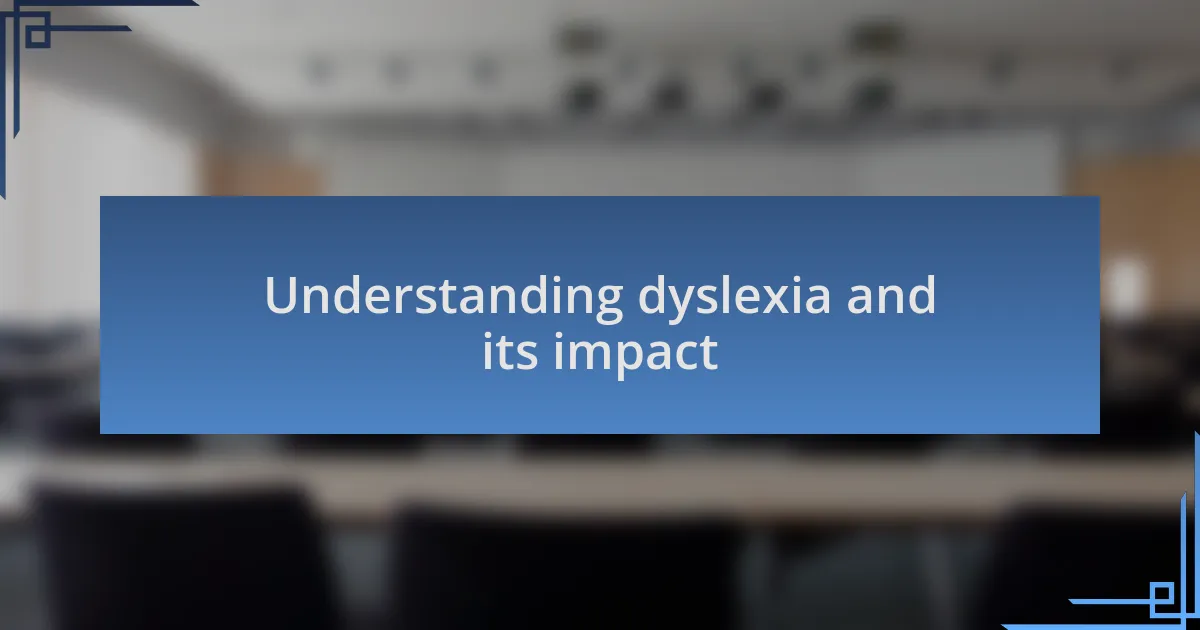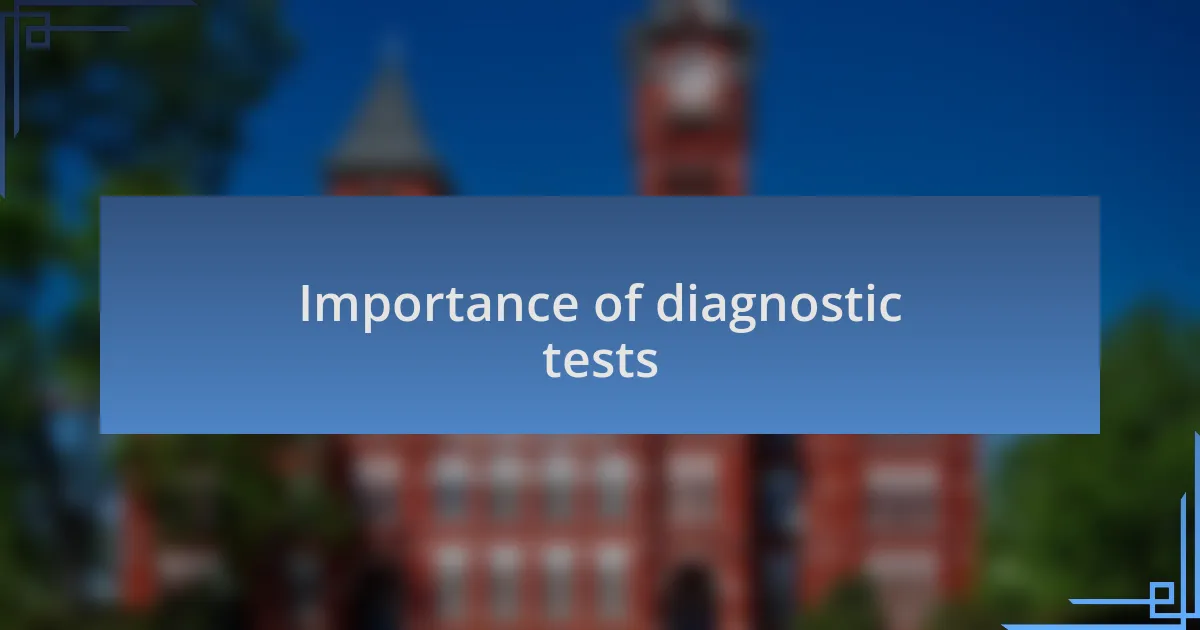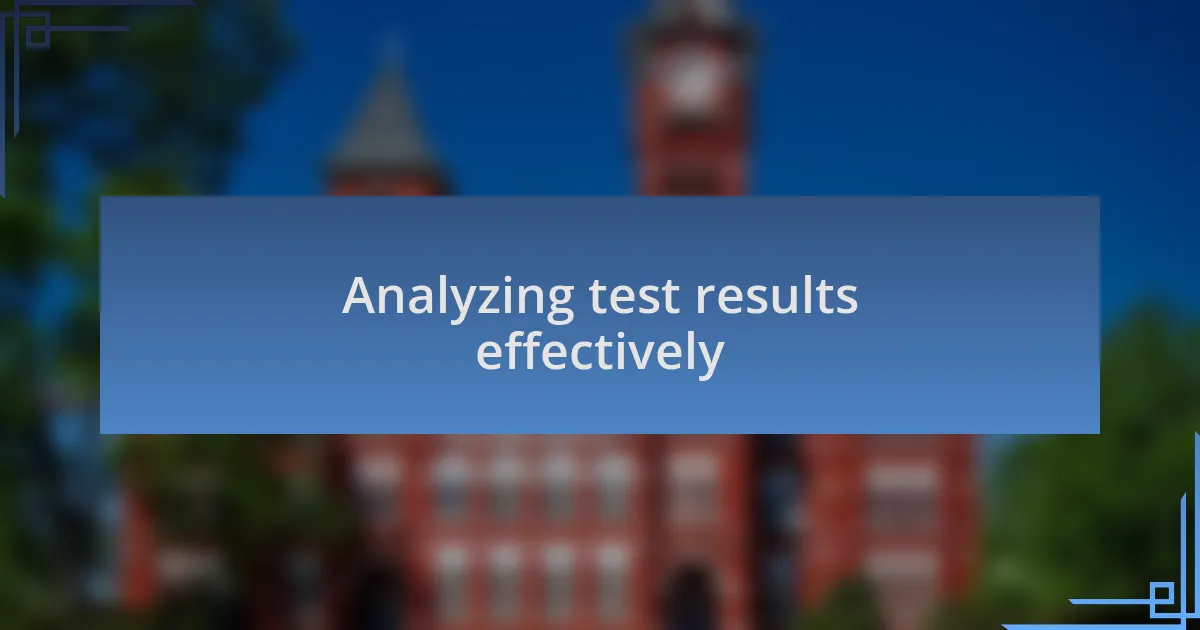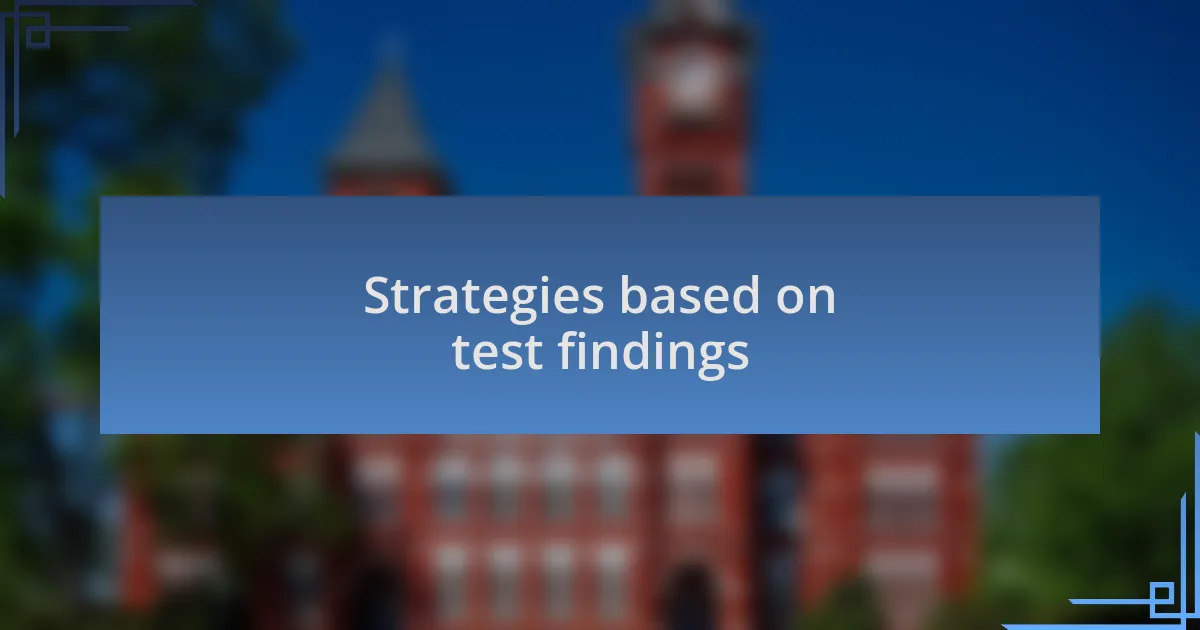Key takeaways:
- Dyslexia affects not only reading abilities but also confidence and emotional well-being, highlighting the need for early and accurate diagnosis.
- Diagnostic tests provide critical insights that empower tailored interventions, ultimately unlocking an individual’s potential and improving engagement.
- Analyzing test results facilitates targeted strategies by identifying specific needs and strengths, fostering a collaborative approach among educators, parents, and specialists.
- Building on students’ strengths and involving families in the learning process significantly enhances children’s educational experiences and outcomes.

Understanding dyslexia and its impact
Dyslexia is often misunderstood as simply a reading difficulty, but its effects stretch far beyond the classroom. I remember working with a young student who, despite his bright mind, struggled to express his thoughts on paper. This led to frustration and a fear of participation in discussions, highlighting how dyslexia can silently undermine a person’s confidence and self-esteem.
The struggle to decode words can feel like climbing a mountain every day. Have you ever seen someone pour their heart into a project, only to feel defeated by the words they can’t quite grasp? For many with dyslexia, this daily battle can lead to anxiety, not just around reading, but about their overall capabilities in academic or social settings.
Understanding dyslexia means recognizing that it isn’t just an academic challenge—it’s an emotional journey. I once met a parent whose child was misdiagnosed, leading to years of unnecessary hardship. This experience underscored for me the importance of early and accurate diagnosis—not only to address the academic needs but to foster a supportive environment that nurtures more than just literacy skills.

Importance of diagnostic tests
Diagnostic tests play a crucial role in identifying dyslexia, clarifying whether someone truly has this learning difference rather than simply struggling with traditional teaching methods. I recall a case where a comprehensive evaluation brought to light a hidden pattern of symptoms that had gone unrecognized for years. This breakthrough not only transformed the student’s learning plan but also illuminated pathways that had previously felt like dead ends.
Moreover, having accurate diagnostic results empowers educators and parents to craft tailored interventions that cater to individual needs. I once collaborated with a teacher who was skeptical of diagnostic tests, viewing them as just paperwork. However, after we implemented a student’s personalized learning strategy based on his test results, she witnessed a remarkable change in his engagement and performance. Isn’t it incredible how precise data can unlock a child’s potential and lead them toward success?
Furthermore, diagnostic testing breeds a sense of validation for the individuals affected by dyslexia. I remember celebrating a student’s diagnosis with her; it was as if a weight had been lifted. The relief she felt upon realizing that her struggles had a name—and a solution—was profound. Shouldn’t everyone experiencing similar challenges have access to that same understanding and support?

Analyzing test results effectively
Analyzing the results of diagnostic tests is essential for understanding an individual’s unique needs. I remember reviewing a student’s test scores that showed a significant discrepancy between oral and written language skills. This realization guided us to focus on strategies that emphasized oral expression, and the transformation was remarkable. Have you ever noticed how small adjustments can lead to big improvements?
It’s critical to view these results as not just numbers but stories waiting to be told. For instance, after examining the breakdown of a student’s phonological awareness scores, I recognized the specific areas that needed attention. It was like piecing together a puzzle. The insights gained were not just about academic performance but also about building the student’s confidence. Can you imagine how empowering it feels to know exactly where to direct your efforts?
Moreover, when analyzing test results, I try to share my discoveries with the entire support team—parents, teachers, and specialists alike. In one instance, a collaborative meeting centered around a student’s profile led to a unified approach that included home activities and classroom modifications. This synergy not only improved the child’s learning experience but also strengthened the partnerships that foster success. Isn’t it inspiring how working together can turn data into dynamic, personalized learning strategies?

Personal insights from diagnostic tests
The insights gained from diagnostic tests can be transformative, both for students and for those who support them. I remember a time when a young learner’s results highlighted their incredible visual memory but showed struggles with retention in reading. This revelation sparked a creative approach—using visual aids and storytelling to anchor their learning. Have you ever seen a student light up when they finally connect the dots? It’s moments like these that remind me of the power of tailored instruction.
Reflecting on the emotional side of these tests is equally important. One particular assessment revealed that a student was not just struggling academically but was also feeling increasingly anxious about their reading abilities. I decided to incorporate mindfulness techniques into our sessions, and the shift was palpable. Can you envision how much more effective learning becomes when it’s paired with emotional support? This experience underscored the notion that diagnostic tests are not merely tools—they provide a roadmap for fostering resilience and confidence.
At times, I find that sharing these insights with the wider community can create meaningful change. Once, during a workshop, I delved into diagnostic findings and explanation strategies, and the feedback was enlightening. Educators expressed how understanding these test results helped them approach their teaching with new perspectives. Isn’t it fascinating how the sharing of insights can ripple through a community, inspiring collective action toward better support for all learners?

Strategies based on test findings
When it comes to developing strategies based on test findings, I often rely on targeted interventions. For example, after assessing a student who excelled in auditory processing but struggled with phonemic awareness, I implemented a series of listening exercises that emphasized sound segmentation. The leap they made toward decoding words was truly impressive. Have you ever witnessed the joy when a struggling reader finally grasps a concept? Those moments reinforce the value of individualized strategies.
Another key aspect I’ve encountered is the importance of building on strengths rather than just addressing weaknesses. I worked with a young girl who demonstrated exceptional storytelling skills during her assessments, yet her written work was a challenge. By integrating creative writing into our sessions, I encouraged her to express herself through narrative first, which built her confidence. It’s interesting how sometimes, it only takes one small shift to create a bigger impact—don’t you think that’s a powerful approach?
Lastly, I advocate for the involvement of families in the strategy development process. In a recent case, a student’s test results revealed not just academic needs but also a lack of engagement at home. By organizing workshops for parents, I facilitated discussions on how they could support their child’s learning journey. Isn’t it striking how collaboration between educators and families can amplify the success of a child? Through these efforts, I’ve witnessed remarkable transformations that remind me of the shared responsibility we all have in nurturing learning.